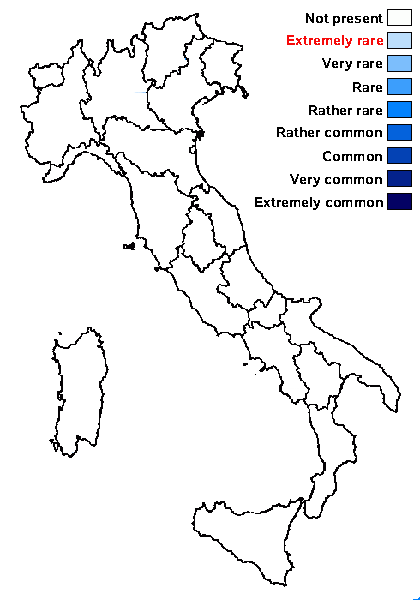Micarea byssacea (Th. Fr.) Czarnota, Guzow-Krzem. & Coppins
in Czarnota & Guzow-Krzemińska, Lichenologist, 42: 17, 2010. Basionym: Catillaria prasina var. byssacea Th. Fr. - Lich. Scand., 2: 573, 1874
Synonyms:
Distribution:
Description: Thallus crustose, thinly episubstratic, green to olive-green, consisting of small granular goniocysts surrounded by a K± violet gel. Apothecia micareoid, usually abundant, olive- or whitish-grey, grey to grey black, rarely a few whitish to cream-coloured, (0.1-)0.2-0.6(-0.7) mm across, mostly adnate, convex to hemispherical, immarginate from the beginning but often with a paler, whitish outer part. Proper exciple developed only in young apothecia, colourless, 10-20 μm wide, of paraphysis-like hyphae; hymenium colourless, or slightly olivaceous grey in darker apothecia, the pigment confined to the gel matrix, K± violet, C± violet; paraphyses richly branched and anastomosing, 0.8-1.2 μm thick; hypothecium colourless to yellowish. Asci 8-spored, clavate to cylindrical-clavate; in K/I with a blue outer layer and apical dome and unstained wall, the dome with an apical cushion. Ascospores 0(-1)-septate, hyaline, cylindrical to ellipsoid, (6-)8-12(-13) x 2.7-3.5(-4.2) μm. Pycnidia white to greyish-white, with gaping ostioles, sessile or immersed between goniocysts, up to 40(-50) μm across, the wall around the ostiole colourless to slightly olivaceous and then K± violet, C± violet. Mesoconidia (3.8-)4.5-5.5 x 1.2-1.5 μm; microconidia 5-7.5(-8) x 0.8-1 μm. Photobiont micareoid, the cells 4-7 μm wide. Spot tests: thallus and apothecia K- or K+ faintly violet, C- or C+ faintly violet, KC-, P-. Chemistry: thallus with methoxymicareic acid; pigmented parts of apothecia with the Sedifolia-grey pigment. Note: a mainly epiphytic species growing on the bark of trees, especially of deciduous species, reported from several localities in Western Europe but probably more widespread. Some old records of M. prasina may refer to this species. To be looked for in Italy.
Growth form: Crustose
Substrata: bark
Photobiont: green algae other than Trentepohlia
Reproductive strategy: mainly sexual
Most common in areas with a humid-warm climate (e.g. most of Tyrrenian Italy)

Predictive model
Growth form: Crustose
Substrata: bark
Photobiont: green algae other than Trentepohlia
Reproductive strategy: mainly sexual
Most common in areas with a humid-warm climate (e.g. most of Tyrrenian Italy)

Predictive model


